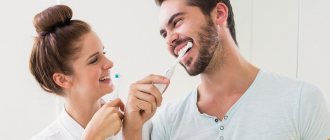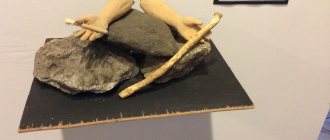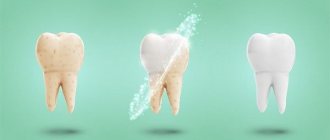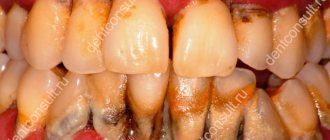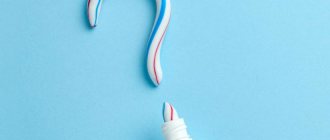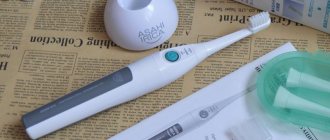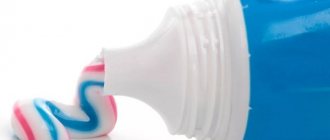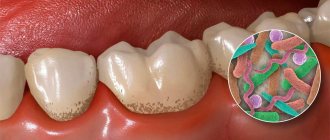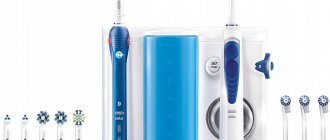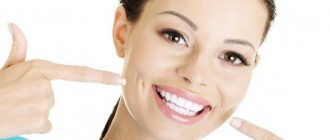If you've run out of toothpaste, don't go shopping, or just want to replace your toothpaste with something else, then you should read this article. It discusses alternative options for brushing your teeth. Making toothpaste at home is easy, and there are also natural remedies.
Girl gnawing vegetables
The importance of brushing your teeth. How often is the procedure recommended?
Proper prevention and care of dental diseases consists of daily brushing of teeth with a toothbrush and toothpaste twice a day . It is not recommended less often, since plaque can accumulate on the teeth; more often, it is not recommended, because the enamel can be damaged.
If you do not clean regularly, you may encounter the following problems :
- bad breath;
- plaque and yellowish color;
- dental diseases (caries, stomatitis, etc.).
Important! Dentists recommend brushing your teeth before breakfast, not after. This is due to a biofilm of plaque and bacteria remaining on the teeth after a night’s sleep.
Types of plaque
- Soft. Formed on teeth during human life. It is not noticeable on the surface of the enamel and is easily removed from it using hygiene products.
- Solid. Once hardened, it is almost impossible to remove plaque from teeth at home.
- Supragingival stone. Formed from hard plaque. Outwardly it looks like a small dark-colored rim in the cervical area.
- Subgingival stone. It is formed under the gum, so it is not visually noticeable. It can only be detected using a special dental probe or an x-ray. If subgingival stone is not removed in time, gum resection may occur.
What and how to brush your teeth if you don’t have toothpaste?
There are situations when a tube of paste is completely empty, and there is no time or desire to run to the store for a new one.
What to do? Do you really have to go to work or school with unbrushed teeth and cover your mouth every time you have contact with other people? No, you can find toothpaste substitutes at home, which will be no worse in effect, maybe even better .
Tea tree oil
In addition to the usual remedy, you can brush your teeth with tea tree oil, rubbing it into the tooth enamel . It has an amazing whitening effect that occurs naturally, without any harmful effects or destruction.
Tea tree oil will not only help clean teeth from plaque, but also strengthen enamel, prevent inflammation and disinfect the oral cavity .
By the way! It is worth paying attention to a significant disadvantage of the product - a sharp, specific smell and bitter taste.
Salt
Table salt is extremely effective for cleaning teeth, as it has antiseptic, anti-inflammatory and regenerating effects . Salt can eliminate bad breath.
It's extremely easy to use:
- dip the brush in water;
- apply salt to it;
- clean without sudden movements or strong pressure.
Baking soda
Baking soda can clean enamel well, but you should only use it in extreme cases. With frequent use, it can damage the enamel, depleting it .
Experts recommend brushing your teeth with baking soda no more than once a week .
Cleaning with baking soda is equivalent to professional cleaning (in terms of impact).
Powdered milk
Powdered milk is ideal for those who suffer from bleeding gums or who have tartar . It eliminates unpleasant odors well, however, the effect is short-lived.
Powdered milk must be used as a dry powder.
Clay powder
Clay powder requires extra effort to create, but the effect is worth it. Your teeth will be noticeably whiter after the first use.
For cooking you need:
- Dry the white clay.
- Grind it into powder.
- Add a couple of drops of your favorite essential oil to eliminate unpleasant odor and taste (fir or mint is recommended).
For your information! You can buy ready-made white clay powder in stores, however, it will cost much more.
Activated carbon
Activated carbon not only makes teeth whiter, but also removes age spots, normalizes oral microflora, and fights toxins .
Like others, good ones eliminate bad breath. It is not recommended to use activated carbon as a paste on an ongoing basis, as it can damage the enamel .
Hydrogen peroxide
Hydrogen peroxide can be considered as a toothpaste substitute. Like baking soda, the solution is analogous to professional teeth cleaning, however, it is more gentle .
Important! It is not recommended to use more than once a week.
Hydrogen peroxide will eliminate yellowness, remove unpleasant odor, and also have an antiseptic effect.
Industrial toothpaste substitutes
Tooth powders
The most popular products include well-known tooth powders.
Teeth cleaning powders include:
- Calcium carbonate, which is the basis of the mixture;
- Supplements The role of additives is most often performed by clay, sodium carbonate and aluminum chloride;
- Flavors and flavoring additives;
- Excipients. Natural additives that perform certain functions are used as such substances. For example, essential oils have an antiseptic effect, sea salt has an antibacterial and anti-inflammatory effect.
The difference between powder when replacing toothpaste
- The abrasive particles of tooth powder are larger and sharper than those of toothpaste.
- The dry structure of the powder contains a large number of microparticles, allowing for better cleaning than a paste-like consistency.
- The powder contains fewer unnatural components than the paste.
- Toothpastes, due to their structure and the ability to add medicinal components, can be part of complex therapy for various diseases.
- Toothpastes, due to hermetic packaging and dosing capabilities, are considered more hygienic than powders sold in jars that open completely, causing the contents to come into contact with the external environment.
- Dry powders are not able to provide significant antimicrobial protection, unlike toothpastes.
- Tooth powder, being an abrasive product, may not be suitable for people with sensitive enamel.
- Toothpastes may contain quite aggressive chemical components sodium lauryl sulfate and triclosan.
- The powders are biologically neutral due to their natural composition.
Cons of tooth powders
The relative disadvantages of powders include the fact that with prolonged or frequent use, they, like whitening toothpastes, can lead to thinning of the enamel. In addition, if the powder is stored in an open container in close contact with the environment, it may become contaminated with pathogenic bacteria, which in turn can lead to infection of the mucous membranes of the oral cavity. Otherwise, tooth powder can be a worthy replacement for toothpaste in most cases.
Irrigators
Mechanisms that are acceptable for home use and essentially have no serious contraindications. The essence of the device is the targeted effect of a stream of water, which, due to the high pressure, washes away plaque and has a massaging effect on the gums.
It is customary to distinguish three main types of irrigators:
- Stationary. They operate from the network at a power of 220 Volts. The main operating mechanism is a compressor that provides water supply;
- Portable (travel). Work is carried out from a battery or batteries;
- Connected to the water supply network. Connect directly to the water tap using the included adapters.
The irrigator can have an effect on the oral cavity with both ordinary water and various medicinal compositions. In fact, this is one of the best options for replacing toothpaste for people of any age. The irrigator may be especially relevant for pregnant women, people who have orthopedic or prosthetic structures in their mouths, and people suffering from various diseases of the gums and mucous membranes.
Ways to brush without a toothbrush
There are situations when there is no brush at hand. For example, after spending the night away from home, you want to freshen your breath, but not everyone will carry a toothbrush with them. However, there are a number of alternative things that can help you brush your teeth without a special brush .
Napkin or paper towel
Ideally, you should use a hard napkin, but if you don’t have one on hand, you can use a regular paper towel or a disposable handkerchief. Algorithm of actions :
- Wrap a napkin around your finger in several layers, wet it slightly and apply toothpaste (if you have it, of course).
- Brush your teeth as if you were using a regular brush.
- You can change the napkin and clean your tongue and gums in the same way.
Siwak tree sticks
These sticks can be ordered online in vacuum packaging, which contains several pieces at once.
In ancient times they were actually used for cleaning and did a relatively good job. One stick can be used for a month.
You just need to adhere to the general storage rules: siwak wood sticks open to prevent mold from forming and store in a non-humid place .
Cleaning her teeth is quite simple - you just need to chew it, after scraping off the bark .
Attention! In “field conditions” you can simply find a 15-20 centimeter stick, peel off the top skin (it should be without hard bark) and use it instead of a toothbrush.
Cleaning with your finger
If you don't have anything at hand, you can use your own finger. First, you need to thoroughly wash your hands , then use your index finger to clean, making circular movements over your teeth and gums .
If you have toothpaste, you can first apply it to your finger.
It is necessary to wash your finger thoroughly when moving from brushing the lower teeth to the upper ones (or vice versa).
What can you replace toothpaste with: conclusion
Having considered all of the above methods for replacing toothpaste, we can come to the conclusion that it is advisable to combine most of them, and some (salt, soda, charcoal, etc.) are not suitable for long-term use due to their powerful abrasive properties. One of the most effective and safe alternatives can be considered an irrigator and herbal mixtures.
In the question “ what to replace toothpaste with ,” all the methods indicated can be suitable, subject to the rules of use and the absence of abuse. We also recommend that you read our article: how often should you change your toothbrush, as well as the article on how to brush your teeth correctly:.
Additional methods of oral hygiene
There are a number of products on the dental market that help maintain oral hygiene. They can also be useful for cleaning teeth on an occasional basis.
Rinse aids
Mouth rinses are not intended to fully clean teeth . They only kill harmful bacteria located in the oral cavity and prevent the formation of plaque.
Without brushing your teeth, they will not completely remove plaque; your teeth will only be partially cleaned; however, in the absence of other options, this situation is not so bad.
Rinse for cleaning for approximately 1 minute.
Dental floss
Dental floss is unlikely to clean all of your tooth enamel. With its help, you can only complement the cleaning process by eliminating plaque in hard-to-reach places , but cannot replace it in any way.
Without toothpaste and a brush, dental floss will not be suitable for cleaning enamel.
Chewing gum
Chewing gum can partially remove plaque from tooth enamel and freshen your breath well .
For your information! It is recommended to use it after meals, as due to its texture, it effectively cleanses the oral cavity of bacteria remaining after a meal.
It can replace your morning wash, but you shouldn’t expect the effect of toothpaste and brush.
Green tea
To clean your teeth, it is enough to drink green tea, but for greater effect it is recommended to rinse your mouth with it. The herbal drink removes plaque well and has an anti-inflammatory effect .
Fruits and vegetables that clean your teeth
Fibrous fruits and vegetables can help fight plaque because they contain acids and vitamins that help whiten tooth enamel. They help fight tooth decay .
Fruits and vegetables that clean your teeth:
- apples;
- carrot;
- celery.
Causes of congestion
- Insufficient oral hygiene, incorrectly selected hygiene products.
- Eating a lot of sweets, sticky foods, rich in light carbohydrates, and at the same time a small amount of solid foods, such as vegetables, in the diet.
- Abuse of products that have a coloring effect. Tea, coffee, cola, carbonated drinks - all this leads to the fact that the plaque turns brownish and, after hardening, spoils the smile.
- Diseases of internal organs. Patients with diseases of the gastrointestinal tract and endocrine system are prone to the formation of plaque on their teeth.
- Partial edentia, malocclusion, severe crowding of teeth.
Patients with bridge prostheses are at risk. The bridge is fixed on the supporting tooth. Food particles get trapped under the crown. In this case, cleaning plaque on teeth with conventional means is impossible. As a result, it grows, microorganisms attack the gums and supporting teeth, and it becomes mobile. If you have dentures, you should definitely visit your dentist for professional cleaning.
Clay
What to do if you don't have toothpaste? How to brush your teeth? A good idea would be to use white or blue clay powder. The product is absolutely harmless to the body. The substance contains an abundance of microelements that disinfect oral tissues. Brushing your teeth with clay helps eliminate bad odor.
To rid the enamel of plaque, freshen breath and achieve a whitening effect, I act according to the following principle:
- take about 50-70 grams of white or blue clay;
- the product is moistened with a few drops of water;
- the product is mixed until a mass of paste-like consistency is formed;
- add a dessert spoon of liquid honey, as well as a couple of drops of propolis infusion, essential oils of sage and chamomile.
The prepared paste is applied to a damp brush. Brush your teeth, carefully treating the enamel surfaces. Finally, rinse your mouth with water. Performing the procedure in the morning and evening has the most positive effect on oral health.
Healing herbs
When looking for effective folk remedies for cleaning teeth, you should pay attention to plants such as mint, sage, calamus root, thyme, and cloves. These herbs are combined in equal proportions and ground to a powdery consistency. The resulting product is applied to a moistened brush. Perform delicate teeth cleaning. Using the method allows you to remove plaque, disinfect the oral cavity and improve the condition of the gums.
Use dental floss and mouthwash
Dmytro Panchenko/Thinkstock
If you forgot your toothbrush and don’t have any toothpaste, but have dental floss and mouthwash , you can brush your teeth no worse than at home with your usual hygiene products.
1. Use dental floss to remove hard pieces of food stuck between your teeth;
2. Rinse your mouth thoroughly with water;
3. Finally, rinse your mouth with mouthwash to kill any remaining bacteria.
Yes, of course, we understand that the likelihood that you forgot your toothbrush, but put dental floss and mouthwash in your bag, is very small, but this is perhaps the best option (we recommend always having this “gentleman’s” kit with you) in his bag).
Tartar can only be removed in a clinic
Gradually, the plaque hardens, mineralizes and turns into tartar. In addition to the fact that teeth acquire an unpleasant yellowish tint near the roots, the stone contributes to the growth of soft plaque, potentially increasing the risk of gum pocket inflammation and periodontal disease.
Tartar removal: before and after
While soft plaque is difficult to remove at home, tartar is impossible. Even abrasive pastes, for example, based on salt or coal (these are sold in lines of “natural” cosmetic products), will not affect it in any way.
Wood ash
What can you use to brush your teeth instead of toothpaste? An ancient folk method is the use of ash. In nature, cooled coals should be taken from the fire. The substance is ground into powder. Add a couple of drops of water until a thick, paste-like consistency is formed. The product is applied to the finger and passed over the surfaces of the teeth. Finally, rinse your mouth with plenty of water. As a result, the enamel gets rid of accumulated plaque and becomes clean and snow-white.
Wood ash is more than just an abrasive. The product contains potassium, calcium, phosphorus, manganese, iron. The complex of these elements creates a special environment in the oral cavity that is not suitable for the active reproduction of pathogenic microorganisms. If you add ground mint leaves to a paste prepared from ash, you can get a product with a pleasant taste and aroma.
Chew gum (sugar-free)
recyclingnation.com
Just like chewing vegetables, chewing gum can be a great way to remove plaque when brushing is not an option.
Chewing gum can dislodge any food particles remaining in the teeth and produce saliva, which is a natural disinfectant for rinsing the mouth and killing bacteria.
It is recommended to avoid sweets and use sugar-free chewing gum .
Kitchen salt
The mineral substance is known for its disinfecting properties. Thanks to its crystalline structure, the product perfectly cleanses plaque from tooth enamel. The effect of salt on the gums reduces the likelihood of developing inflammatory and putrefactive processes. The oral cavity gets rid of unpleasant odor.
You can use sea salt to clean your teeth. The product is a source of a wide range of microelements: iodine, manganese, phosphorus, calcium, silicon, iron. The noted elements have an antiseptic effect on the tissues of the oral cavity.
How to brush your teeth without toothpaste? The salt is thoroughly ground in a mortar until it becomes dusty. Add a couple of drops of vegetable oil. A damp brush is dipped in the substance. Next, teeth are brushed according to the usual principle. Finally, the oral cavity is thoroughly rinsed with water.
